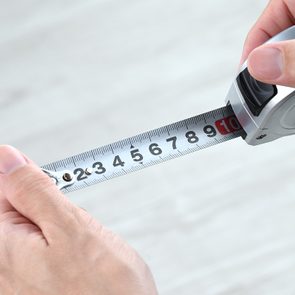If you've wondered how many feet in a mile, blame the ancient Romans

Why Are There 5,280 Feet in a Mile?

Nearly every country in the world uses the metric system as its official system of weights and measurements. Yes, fellow Americans, we are among the exceptions to this rule, but there’s no use crying over a spilt liter of milk. The customary system has its own cool history. Well, one unit of the customary system does: the mile. But, how many feet in a mile? It’s one of those little things we’ve always wondered about. We get to the bottom of this question and dive into the historical reasons behind the number of feet in a mile.
Get Reader’s Digest’s Read Up newsletter for more fun facts, news, humor, cleaning, travel, and tech all week long.
How many feet in a mile?
It can be tricky to remember how many feet in a mile, since it’s a seemingly random number: 5,280. But where did miles as a unit of measurement even come from?
According to Mental Floss, the modern mile has its origins in Roman antiquity. The term “mile” is derived from the Latin mille passum, meaning “a thousand paces.” A pace, in Roman times, was equivalent in length to five human feet lined up from toe to heel. Romans happened to be a bit smaller than modern humans, so 5,000 Roman “feet” would equate to about 4,850 modern human “feet.” That means the entire road system of the Roman Empire (over 250,000 miles of roads) consists of over 1.25 billion “feet.” But that’s not the only contribution Romans made to American life.
How did it become 5,280 feet?
While the basis of this measurement was Roman, the jump of 280 feet was positively British. In 1592, Parliament wanted to standardize the measurement of the mile and decided that it should be equal to eight furlongs. Furlongs, which are still used as a unit of measurement in horse racing, are 660 feet long. Six hundred sixty times eight equals, you guessed it, 5,280.
If you’re wondering why Britain cared about how many feet in a mile when they use the metric system, you might be surprised to learn that the United Kingdom actually does use miles in some cases! The Imperial System that America uses started as the British Imperial System, and Britain brought its measurement system when it colonized the Americas. Though they switched over to the metric system in the mid- to late 20th century, you can still see some “miles per hour” signs on British roads.
A quick trick to remember how many feet in a mile
Regardless of how it came to be, how many feet in a mile can be a tricky number to keep straight. Luckily, the Internet has you covered. A simple memory trick, posted on Reddit, makes it easy. Think of five tomatoes: Each syllable of that phrase represents a number in the four-digit 5,280. “Five,” “two,” “m-eight,” and “oh’s” for zero.
Without the Romans, there would be no name or baseline for the mile. Without the British, it might be a more rounded length. Thanks to tomatoes, you can easily recall the strange number.
Why trust us
At Reader’s Digest, we’re committed to producing high-quality content by writers with expertise and experience in their field in consultation with relevant, qualified experts. We rely on reputable primary sources, including government and professional organizations and academic institutions as well as our writers’ personal experiences where appropriate. We verify all facts and data, back them with credible sourcing and revisit them over time to ensure they remain accurate and up to date. Read more about our team, our contributors and our editorial policies.
Sources:
- Mental Floss: “The Origins of 7 Common Units of Measurement”
- Britannica: “British Imperial System”
- Reddit: “A handy way to remember how many feet in a mile”






















